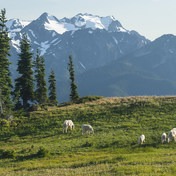Given its latitude, North America, and the United States in particular, is not a place typically associated with rainforests. Still, there are pockets throughout the country where rainfall and temperatures align to create lush, dense forests that are straight out of a fantasy novel: a rain-soaked landscape where moss drips from evergreen boughs, downed giants are unrecognizable under the overgrowth of the forest understory, and long shadows hide dark and misty corners that remain empty to the specters of the imagination.
For this week’s installment of the #52WeekAdventureChallenge, we celebrate the American rainforest. There are few, and the few that exist are generally small, but their rarity and uniqueness makes them even more worthy of celebration.
With the exception of Hawai'i and territories like Puerto Rico, the entirety of the United States lies north of the 25th parallel and outside of the tropics. That means that most of its rainforests fall in a temperate zone and thus are considered temperate rainforests, and temperate rainforests are distinct from tropical rainforests in several important ways. By definition, though there are several, a temperate rainforest receives more than 55 inches of precipitation annually, and the average temperature hovers between 39 and 54 degrees. Also, the trees have extraordinary lifespans ranging from 500 to 1,000 years or longer. They are places suspended in time, where lives are long and decomposition is slow.
In the United States, there are two main regions where temperate rainforests are found. The Pacific temperate rainforests, which span from Big Sur in California to the Kenai Peninsula in Alaska, encompass the largest area of temperate rainforests in the world. They also spawn the tallest trees in the world. While logging in the 19th and 20th centuries nearly wiped out Northern California’s redwoods, leaving less than 5% of the old-growth rainforests, those that are left behind are arboreal giants taller than 350 feet. This region includes the Olympic Peninsula in the state of Washington, which gets the most rain in the continental U.S., around 150 inches per year.
- Redwood National and State Parks
- Mount Rainier National Park
- Olympic National Park
- North Cascades National Park
- Glacier Bay National Park
- Wrangell-St. Elias National Park
In parts of Virginia, North Carolina, Georgia, and Tennessee, the Appalachian Mountains harbor what some consider to be the United States’ other large pocket of temperate rainforest. The Great Smoky Mountains receive up to 95 inches of rain per year, and it’s one of the world’s most biodiverse ecoregions. In 1998, an All Taxa Biodiversity Inventory, which aimed to catalog all life in the Smokies, discovered 10,000 new species not previously known to live in the park, and about 1,000 of these were new to science.
Does the United States have any tropical rainforests? The answer is yes, but only above 3,750 feet. Hawai'i falls within the tropical latitudes, just barely south of the Tropic of Cancer. Points on the north shore of Kauai are widely known to be the wettest place on earth, receiving more than 400 inches of rain annually—a staggering number that’s hard to comprehend, and one that certainly satisfies part of the typical definition of a rainforest. Visit the Kalalau Trail, and you’ll see what we mean.








Comments
Sign In and share them.